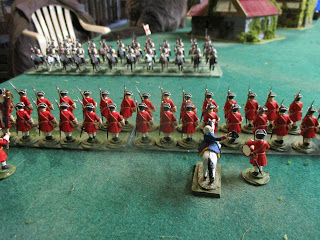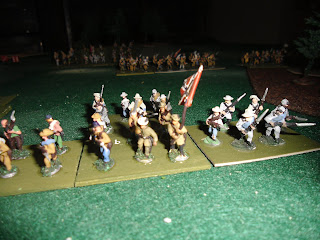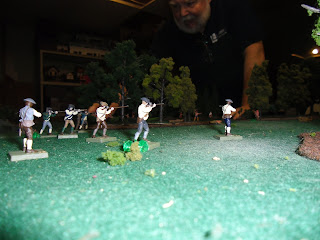The burden of defending England in the great battles of 1066
was borne by a small part of her military strength. The great battles happened
in quick succession and were decisive, leaving most of the English fighting men
no opportunity to take the field against the invaders. One such contingent were
the men owing service to Ealdorman Earwig of North Anglia. In peace and war
this forgotten corner of England was left largely unmolested. However, in the
spring of 1067 William, newly crowned King of England, was casting about for
lands to reward his followers. One of his lesser Barons, Ralph of Amiens,
called “Short Sword”, but never in his presence, was assigned the lands of
Ealdorman Earwig, if he could evict the current occupant.
Ealdorman Earwig deploys his men
Norman foot take up position
Ralph made his way north with his followers; 135 horsemen,
144 spearmen, 72 archers and 36 axmen. Soon after crossing into North Anglia he
was confronted by the army of Ealdorman Earwig. The English force consisted of
432 men. A third of them were his housecarls, well armored and armed with the
dread Danish long axe. The rest were the Fyrd, reliable men but armed with
shield, spear and long knife only. They were, for the most part, unarmored. The
ground between the two armies was broken by rough hills and scattered copses of
oak. A bad place to fight for both sides, but the leaders were determined to
settle the business then and there. The Normans formed up in three bodies with
roughly equal numbers of horse and foot in each. The English slid down off
their ponies and sent them to the rear. They then formed in three contingents
with the housecarls evenly divided between them.
Stalwart Saxon Fyrdmen deploy
Ralph directed the infantry of his left wing to occupy a
rough hill in a defensive stance while the horsemen of this contingent advanced
to support his center. The center of the Norman host moved straight forward
against the English line opposite them. The Norman right was assigned the honor
of striking the decisive blow. The infantry on this side was directed to take
the hill that anchored the English left while the mounted men swept around the
enemy flank to roll up their line.
The Norman center deploys
The Norman left holds
In the event the slow moving foot of the Saxon right swung
around to align with the Norman foot defending the hill on that side of the
field. They shrugged off the ineffectual Norman archery and assaulted the hill
as ordered. The fighting here was indecisive and the issue was settled
elsewhere. The mounted Normans in this part of the field were so poorly
deployed they played no part in the battle. They spent their time edging away
from the advancing English in an effort to not be caught among the trees and
cut up by their dismounted foes.
Norman Milites on the left embarrass themselves
The centers of the two armies engaged in a protracted and
indecisive contest with first one side and then the other gaining some small
advantage which never developed into a breakthrough. The Norman right fared
better. The infantry element of this wing was sent forward according to plan to
assault the English foot holding the hill
anchoring this flank. The housecarls on the summit were in no mood to give ground, and sent the attackers reeling back.
Housecarls hold the hill anchoring the English left
At the same time the mounted Normans moved
quickly around the English left and attacked a smaller force of Fyrd posted behind the hill to prevent just such a
move. The Fyrdmen resisted bravely but, against the relentless assault of the
mounted Norman elite there could be only one end. The Normans rode over the
defenders and on toward the enemy camp. The English right broke and fled the
field. Earwig, seeing the writing on the wall ordered the rest of his army to
withdraw and live to fight another day.
Norman right wing horse descends on Saxon Fyrd
Mike and I played this game of Big DBA to test drive the new Conquest Games Norman figures I picked up at the Fall In convention. These two armies seem to be a pretty good matchup, although too much terrain on the table kind of muddied the waters. It is a bit of a mystery to me why the English gave up after Hastings. They had vast reserves of manpower to draw on while the Normans would find it difficult to reinforce across the channel.















































